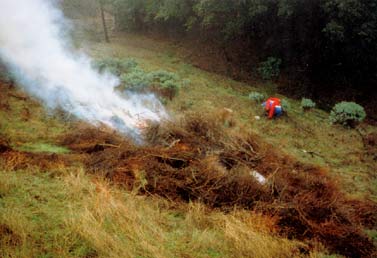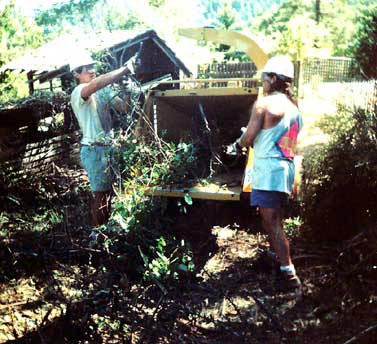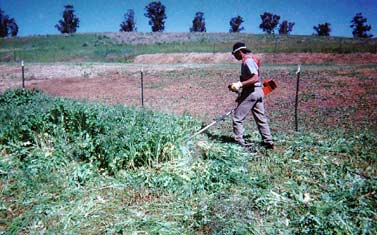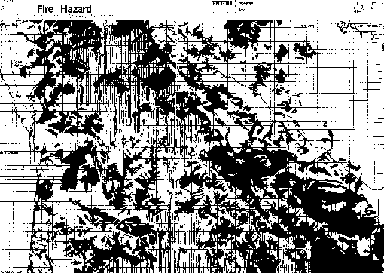
Environmental Concerns
My fellow Americans, we will no doubt survive the worst that Mother Nature can throw at us this Spring, including rain, snow, wind and hail. However, my native California, the land of big time natural disasters, never takes a breather. For example, despite a high tide induced flood in February of '98, with property damages over $5 million here in lower and mid-town Palo Alto, San Francisquito Creek still has the capability to run chocolate brown and 30 feet deep in a winter flood.

Pile burning can be done in a steady drizzle
if tarps
have kept the brush dry. Scotch Broom grows so thickly
here that it can be estimated at several tons per acre.
The flood of '98 could have been far worse had wildfire the Summer before, stripped the hills of their vegetation and thus their water retention capability. Despite this fact, the Palo Alto Rotary declined my request for a letter of endorsement and Stanford University seems intent on a building boom that will add, or has already added, hundreds of acres of impermeable roofs, roads and parking lots to the watershed of San Francisquito Creek.
So, by definition, when it rains heavily and the tide rolls in, all that water will have no place to go except over the levies and into the homes of Palo Alto and East Palo Alto residents. The local Fire District has a jet boat like the ones used in the Florida Everglades but I hope they never have to use it to rescue people from streamside homes in the Gardens neighborhood of East Palo Alto.
Curiously, this same Jekyl and Hyde creek will probably go bone dry at at the Whiskey Gulch/University Avenue bridge by the first of July, just as fire season starts up again. So while it may seem that clear skies will never come, they will, as surely as day follows night.
Fire season will soon be with us again, first in the grasslands, then in the brushy foothills, and finally in the thick fir, oak and redwood forests of the coastal mountain ranges. Plenty of rain this winter, in the long run, simply translates to an abundance of flash fuels on our grasslands and a somewhat postponed beginning of fire season in the heavy timber areas in the mountains.

Almost four tons of brush was fed through this chipper.
Unfortunately for the taxpayer, Californians have built homes in all of those ecosystems and all of those plant communities which are designed to burn. Some people even claim that fire is to our native habitats what rain is the rainforests of the Amazon. As if decades of fuel load build ups weren't enough, you got to figure that exotic invasive plant species are just icing on the cake when a brushfire looks at the menu.
For those of you who have never been in the Bay Area in the springtime, California sunshine and the pounding spring winds off the Pacific will soon wring the last drop of moisture out of all these landscapes and put thousands of rural and suburban homes in peril. As the late author Marc Reisner once pointed out, suburban California, with all those lush green lawns, is a beautiful fraud.
We live in a desert. Homeowners here can expect rain intermittently through early May and then dry weather until at least mid November. Creeks like San Francisquito will continue to flow in their upper reaches only because of life giving fogs that blanket the coast for most of the summer. Trees like the coast redwood have leaves that are designed to collect moisture and can drip 50 inches of "rain" a year. This moisture collects on their leaves just from the fog. And yet this water will dive underground and travel through the gravel beds of the local creeks before reaching the Bay.
There are only a few areas in the world with this bizarre kind of wet-dry climate and Washington, DC is not one of them. It would be news to some in Congress that the Bay Area is drier than Beirut. But thanks to imported water from the Sierras and lush green lawns and trees everywhere, a casual visitor to this area would never know it.
There was a reason that all the fish died in Lake Temescal a few days after the Berkeley hills fire and a sudden lack of dissolved oxygen in the water was not one of them. Ranting and raving aside, maybe it is time that firemen and environmentalists got on the same team. Hand trimming of brush is a small price to pay when one considers the environmental consequences of analysis paralysis.

A worker uses a heavy duty weed wacker to clear
exotic thistle from
a roadside near the Arastradero Preserve in Palo Alto. "The Naturalists"
scene will open with an actor portraying Don Coyne using a tool like
this to cut down oats on the hilldide below his organic garden.
I find it difficult to accept the fact that major environmental groups don't seem to care about "collateral damage" to the environment when these monstrous suburban fires do occur. This leaves a leadership vacuum that few dare enter (save us). Why shouldn't environmental groups, which for the most part are still lily white, care about preserving human life and property? Aren't toxic runoff, siltation and noise pollution three rather unpleasant environmental side effects of suburban brush fires? What do these people think happens when a garage full of paint, pesticides and fertilizers is heated by a fire until it all explodes? It is really nasty.
This is not to say that there hasn't been progress. In the past two decades, fire departments have successfully shouldered the responsibility for hazardous materials spills. The radical environmentalism of the 60's meanwhile, has toned down its rhetoric enough to enter the mainstream and has evolved into genuine concern over human health, property values, biodiversity and the quality of life. If civil rights and environmental health are inseparable then why shouldn't fire departments, which after some struggles have embraced affirmative action, care about the environment?
And not that I want to panic anyone in either community but I feel compelled to point out that we have a serious problem here and no comprehensive plan in place for reducing the risk.....
From Santa Cruz Mountain, Regional Pilot Study, Early Warning, by Tito Patri Completed August 1970 (The hard copy original is located in the San Mateo County Planning Department offices in Redwood City-see Sam Herzburg)
To illustrate the fuel loading problem on a wide scale, almost all of this area on this 1970 map of the mid-Peninsula now has another quarter century plus of fuels accumulation. Areas in solid black represent the heavier fuels on the dryer, southern facing slopes. Downed timber and brush accumulations here may reach an astounding 80 tons per acre.

While this area is not exactly suburbia, people do live in these
areas. While
some are retirees and recluses, to get an idea of how many yuppies live in these
hills and valleys all you really have to do is stand by the side of the road
at the
start of the morning commute and watch the SUV's and sports cars go by.
To some ecologists, the sudden exclusion of fire in this ecosystem represents an environmental shock surpassed only by turn of the century clear cutting of old growth forest. Even in areas devoid of exotics like eucalyptus, (famous for its ability to throw burning embers several miles downwind) this is an unnatural situation and from a fire ecologist's perspective this map must represent a landscape of doom.
Second growth forests are precarious things. The author believes that fuel loads have never been this high in the past 10,000 years of human habitation of this area. Fires burning here in worst case weather conditions would therefore quickly become man made disasters, closing highways and destroying habitat right down to the bottom most layers of soil. And fires starting in the more remote areas after a major summertime earthquake have got to be the modern urban planner's worst nightmare.
The Project / Politics
Involved / Environmental Concerns / Thank
You
![]()